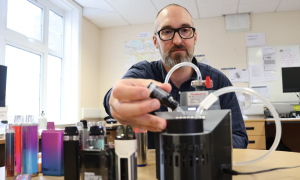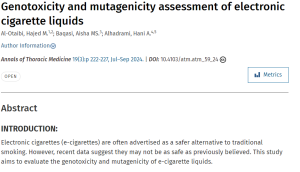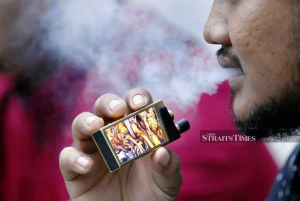Shauna Goldberg Scott, MPH,1Heather S. Feigelson, PhD, MPH,1John David Powers, MS,1Morgan N. Clennin, PhD, MPH,1Jason A. Lyons, MA,1Mark T. Gray, BS,1Anil Vachani, MD, MS,2 and Andrea N. Burnett-Hartman, PhD, MPH1,3
Abstract
Introduction
Our primary purpose is to understand comorbidities and health outcomes associated with electronic nicotine delivery systems (ENDS) use.
Methods
Study participants were Kaiser Permanente (KP) members from eight US regions who joined the Kaiser Permanente Research Bank (KPRB) from September 2015 through December 2019 and completed a questionnaire assessing demographic and behavioral factors, including ENDS and traditional cigarette use. Medical history and health outcomes were obtained from electronic health records. We used multinomial logistic regression to estimate odd ratios (ORs) and 95% confidence intervals (CIs) of current and former ENDS use according to member characteristics, behavioral factors, and clinical history. We used Cox regression to estimate hazard ratios (HRs) and 95% CIs comparing risk of health outcomes according to ENDS use.
Results
Of 119 593 participants, 1594 (1%) reported current ENDS use and 5603 (5%) reported past ENDS use. ENDS users were more likely to be younger, male, gay or lesbian, and American Indian / Alaskan Native or Asian. After adjustment for confounding, current ENDS use was associated with current traditional cigarette use (OR = 39.55; CI:33.44-46.77), current marijuana use (OR = 6.72; CI:5.61-8.05), history of lung cancer (OR = 2.64; CI:1.42-4.92), non-stroke cerebral vascular disease (OR = 1.55; CI:1.21-1.99), and chronic obstructive pulmonary disease (OR = 2.16; CI:1.77-2.63). Current ENDS use was also associated with increased risk of emergency room (ER) visits (HR = 1.17; CI: 1.05-1.30) and death (HR = 1.84; CI:1.02-3.32).
Conclusions
Concurrent traditional cigarette use, marijuana use, and comorbidities were prevalent among those who used ENDS, and current ENDS use was associated with an increased risk of ER visits and death. Additional research focused on health risks associated with concurrent ENDS and traditional cigarette use in those with underlying comorbidities is needed.
Keywords: e-cigarettes, outcomes, comorbidities, tobacco
Introduction
In the United States, about 5.66 million adults currently use electronic nicotine delivery systems (ENDS), also referred to as e-cigarettes.1 Initially, ENDS were marketed to aid in the cessation of traditional cigarette smoking, but ENDS are not approved as a cessation aide and nearly 1 in 4 of those who use ENDS have never used traditional cigarettes.1 ENDS have also been marketed as a safer alternative to traditional cigarettes. However, the risks and benefits of ENDS use are not well defined due to mixed results around their effectiveness as a cessation aide and studies suggesting potential harms associated with ENDS use.2 Notably, the uptake of ENDS among youth and young adults is growing, and ENDS can be a point of entry for nicotine use in these populations. Among those who use ENDS but have never smoked traditional cigarettes, 63.4% are 18-24 years old and 23.8% are 25-34 years old.1
ENDS have been associated with poor health outcomes, including respiratory disease3,4 and poor health outcomes in individuals with COPD or asthma.5 In those without respiratory conditions, wheezing6 and reduced lung function have also been observed.7 However, these prior studies may not have included the impact of traditional cigarette smoking and may not be able to disentangle the effect of long-term traditional cigarette use from the effects of ENDS use. In 2019, the outbreak of ENDS or vaping use-associated lung injury (EVALI), resulted in over 2800 hospitalizations and 68 deaths (https://www.cdc.gov/tobacco/basic_information/e-cigarettes/severe-lung-disease.html). Multiple case reports have described pneumonia, alveolar damage, alveolar hemorrhage, and respiratory distress in patients presenting with EVALI.8–15 It was later identified that these cases were related to vitamin E acetate as additive of some e-cigarettes; however, this EVALI outbreak highlighted the need for additional research on the potential risks associated with ENDS use. Fatal cases of EVALI were more likely to have a history of asthma, cardiac disease, mental health conditions, or obesity compared to non-fatal cases.16 These severe reactions among those with underlying conditions indicate the need for a better understanding of comorbidities among ENDS users and health outcomes associated with ENDS use. Here we examine comorbidities and important health outcomes associated with ENDS use in a large, diverse cohort of adults across the United States.
Methods
Study Population and Setting
The Kaiser Permanente Research Bank (KPRB) is a biorepository that includes longitudinal electronic health record (EHR) information, lifestyle surveys, and biospecimens (saliva or blood) from Kaiser Permanente (KP) adult health plan members across all KP regions, including Colorado, Georgia, Hawaii, Mid-Atlantic States (District of Columbia, Maryland, Virginia), Northern California, Southern California, Northwest Oregon and Washington state (https://researchbank.kaiserpermanente.org/). Starting in September 2015, all adult KP members with a valid email address in the EHR were sent an email invitation to join the KPRB. The proportion of KP members with valid email addresses varies from 50% to 85%, across the regions. To increase recruitment of diverse populations, the KPRB also recruited members without a valid email address using direct mail and in-person outreach. All participants provide informed consent. This study was reviewed and approved by the Institutional Review Board (IRB) at KP Mid-Atlantic States, which is the IRB of record for the KPRB.
We included participants who completed the intake survey between September 2015 and December 2019. We excluded pregnant women due to the potential for pregnancy to change ENDS use, those who did not answer questions on ENDS or traditional cigarette use, and those who did not have at least 12 months of KP membership prior to survey completion.
KPRB Intake Survey
After consent, participants completed a self-administered survey to gather information on physical activity (minutes per week of moderate and vigorous exercise),17 height and weight for calculation of body mass index (BMI), race, ethnicity, education-level, alcohol consumption,18 marijuana use, and history of traditional and ENDS use. The survey included standardized instruments based on Behavioral Risk Factors Surveillance Surveys to assess nicotine use, including: type of tobacco used, age of tobacco initiation, duration of use, and amount of tobacco used per day.19 The survey item used in this study is “Have you ever used electronic cigarettes or other forms of Nicotine Delivery Systems (ENDS) such as E-Hookah or vape pen? (No; Yes, more than a year ago; Yes, in the past year but more than a month ago; Yes, in the past month).”
Electronic Health Record (EHR) Data
All EHR data for this study was extracted from the Virtual Data Warehouse (VDW)20,21 maintained at each KP region. The VDW is a standardized data platform that can be used to collect both retrospective and prospective EHR data. Within the VDW, each healthcare system also maintains a tumor registry that includes records of all cancer diagnoses for health plan members. These tumor registries employ North American Association of Central Cancer Registries (NAACCR) protocols to identify, confirm, and abstract common data elements for each cancer case occurring within the health system.22
The date of survey completion was considered the index date for assessing ENDS use and we ascertained medical history prior to the survey completion date and incident events that occurred after survey completion to use in separate analyses. We used the VDW to extract medical history prior to survey completion (see Supplemental Table 1), including history of chronic obstructive pulmonary disease (COPD), hypertension, hyperlipidemia, asthma, heart attack, stroke, and cancer.23 Longitudinal assessment for study outcomes after survey completion through December 31, 2019 included influenza, pneumonia, incident heart attack, stroke, any cancer, lung cancer only, asthma exacerbation (among those with a history of asthma), emergency room (ER) visits, hospitalizations, and death. We also used the VDW to obtain enrollment status for follow-up and information on basic demographic characteristics including age, sex, race, and ethnicity when these were missing on the survey.
Statistical Analysis
We used multinomial logistic regression to calculate adjusted odds ratios (ORs) and 95% confidence intervals (CIs) comparing the distribution of sociodemographic, behavioral, and clinical characteristics for former and current ENDS users, both compared with never ENDS users as a referent group. For ENDS, current ENDS use was defined as use within the past 30 days, while ENDS use that occurred more than 30 days prior to survey completion was considered former use. Sociodemographic characteristics included: age (categorically 18-25, 26-50, 51-70, ≥71 years old), sex, sexual orientation, race and ethnicity (Hispanic, American Indian / Alaska Native, Non-Hispanic (NH) Asian, NH Black, NH Hawaiian or Other Pacific Islander, NH White, Other), and education (no college degree, associate’s degree, bachelor’s degree, graduate degree or higher). Behavioral characteristics included: traditional cigarette smoking status (never, former, current), marijuana use status (never, former, current), alcohol use (categorized as none, 0.1-0.5, 0.51-2.5, >2.5 drinks per day),24 and physical activity (categorized as < 500, 500-1,000, >1000 metabolic equivalent (MET) minutes per week of moderate or vigorous intensity exercise). Clinical characteristics also included BMI.
Next, individual multinomial logistic regression models were used to compare distributions of selected comorbidities between ENDS use categories while adjusting for sociodemographic and health behavior characteristics listed above. History of the following conditions were analyzed: any cancer, lung cancer only, hypertension, hyperlipidemia, heart attack, stroke, other cerebral vascular disease (transient retinal artery occlusion, transient cerebral ischemia, and other ill-defined cerebral vascular disease), COPD, and asthma.
Individual Cox proportional hazards regression models were used to calculate adjusted hazard ratios (HRs) and 95% CIs comparing the risk of incident health outcomes between ENDS use categories. The health outcomes evaluated included influenza, pneumonia, heart attack, stroke, any cancer, and lung cancer only, in separate models. Additional outcomes included the time to the first emergency room (ER) visit, hospitalization, and death, in separate models. Lastly, for those individuals with a history of asthma, we analyzed the time until the first asthma exacerbation. Cox models were censored at the time of disenrollment from health plan membership, death, or the study end date of 12/31/2019. People with known history of heart attack, stroke or cancer diagnoses prior to survey completion were excluded from these analyses. Each model was adjusted for sociodemographic and health behavior characteristics as above, as well as histories of COPD, hyperlipidemia, and hypertension.
All models included an adjustment covariate for health plan region. Model covariates with missing values had a missing category created to accommodate these cases. This method was chosen due to individual variable missingness rates being less than 4%. Residuals were inspected for the multinomial logistic regression models to identify potential influential and outlying observations, and proportional hazards were checked using plots and simulation tests of cumulative sums Martingale residuals. All statistical analyses were conducted using SAS 9.4 (SAS Institute, Inc., Cary, North Carolina).
Exploratory Analyses
To examine the potential for differences by age, we conducted all analyses stratified by the age 18-25 years old and > 25 years old. We also calculated frequencies of ENDS use by finer strata of racial and ethnic groups to explore differences in ENDS use between racial and ethnic subgroups.
Results
We included 129 119 KPRB participants who completed the intake survey between 9/1/2015 and 12/31/19 (80% of all KPRB participants). We excluded 2532 (1.96%) participants who were pregnant at the time of survey completion or during the study follow-up period, 6789 (5.26%) enrolled in a KP health plan for less than 12 months prior to survey completion, 141 (0.11%) with missing ENDS use, and 64 (0.05%) with missing information on traditional cigarette use. After these exclusions, 119 593 participants were included in analyses. All ORs presented are fully adjusted to account for potential confounders, as described in the Statistical Analysis section.
Patient Characteristics
Of 119 593 participants, 60% were female, 22% >70 years-old, 70% Non-Hispanic (NH) White, 10% Hispanic, 10% NH Asian, 6% NH Black, 2% American Indian/Alaska Native (AI/AN), and 2% other or unknown racial/ethnic groups (Table 1). Overall, 1594 (1%) reported current ENDS use and 5603 (5%) former ENDS use.
Table 1 : Click Here
Former ENDS use was associated with history of lung cancer (OR = 2.47, CI: 1.64-3.72), hypertension with medication (OR = 1.18; CI:1.09-1.28), history of: heart attack (OR=1.45, CI: 1.21-1.74), stroke (OR = 1.44, CI: 1.14-1.81), non-stroke cerebral vascular disease (OR = 1.19; CI:1.003-1.41), COPD (OR = 2.74, CI: 2.43-3.10), and asthma (OR = 1.14; CI:1.03-1.27).
Longitudinal Health Outcomes
There were significant associations with ER visits and current ENDS use (HR = 1.17, CI: 1.05-1.30) and former ENDS use (HR = 1.19, CI:1.12-1.26). Hospitalization was associated with former ENDS use (HR = 1.24; CI:1.11-1.39). Increased risk of death was associated with current ENDS use (HR = 1.84; CI:1.02-3.32), but not with former ENDS use. There were no associations with the other health outcomes evaluated, including influenza, pneumonia, heart attack, stroke, any cancer, lung cancer (Table 3). No association was identified between ENDS use and asthma exacerbation in those with a history of asthma (HR = 0.92, CI:0.69-1.24) (data not shown).
Table 3: Click Here
Exploratory Analyses
In analyses stratified by age 18-25 years compared to >25 years, associations with ENDS use and patient characteristics, clinical history, and outcomes were generally similar across age groups (data not shown). However, we found variation in the prevalence of current and former ENDS use between subgroups of Non-Hispanic Whites and Asians (Supplemental Table 2). Among those classified as NH White, prevalence of current ENDS use for Middle Eastern individuals was 2.6% and former ENDS use was 10.5% compared to 1.2% current ENDS use and 4.0% former ENDS use for NH Whites overall. Among those classified as Asian, lower prevalence of ENDS use was observed among Chinese, Japanese, or South Asians, ranging from <1% to 1.5% for current use and 3.5% to 5.1% for former ENDS use. Conversely, Filipino, Korean, Vietnamese, or Other Southeast Asians had higher prevalence of ENDS use, ranging from 1.5% to 3.5% for current use and from 6.5% to 10.1% for former use.
Discussion
Our findings suggest that people with a history of lung cancer, COPD, asthma, and cerebral vascular disease were more likely to currently use ENDS compared to individuals who did not have a history of these conditions. Increased ER utilization was also associated with current and former ENDS use. Increased risk of hospitalization was associated with former ENDS use, and increased risk of death was associated with current ENDS use. Moreover, we found that ENDS use is often concurrent with traditional cigarettes and marijuana use.
The prevalence of ever use of ENDS was about 6% in our study population. This is lower than estimates from the National Health Interview Survey (NHIS) that reported ENDS ever use from 12.6% in 2014 to 15.3% in 2016.25 In the 2014 NHIS population, prevalence of ENDS ever use varied by age, with 3.7% of those ages 65 and older having ever used ENDS, but 21.6% of 18-25 year-olds reporting ever use of ENDS. The lower overall prevalence of ENDS use reported in the present study may be due to the KPRB population being skewed towards older age groups; 73% of KPRB survey respondents were aged 51 years and older.
Consistent with prior studies,1 we observed that younger age groups, males, gay and lesbian groups, and AI/AN populations had higher prevalence of ENDS use. In contrast to prior research,26 we observed a higher prevalence of current ENDS use in Asians. This result differs from other studies that have found lower ENDS use in Asians,26 and higher prevalence in NH Whites.27 Based on this unexpected finding, we evaluated the prevalence of ENDS use in subsets of Asian populations (Supplemental Table 2), and observed that the higher prevalence of use for Asians was only observed in Filipino, Korean, Vietnamese, and other Southeast Asian populations. These results are consistent with a prior report on traditional cigarette use in Asians which indicated higher rates of traditional cigarette use among Filipino, Korean, and Vietnamese populations compared to Chinese and Japanese populations in the United States.28 Additional research is needed to confirm if ENDS use varies by specific subgroups of broader racial or ethnic populations.
We observed a higher prevalence of ENDS use among individuals that currently use traditional cigarettes or marijuana, as observed in other studies.1,27 Health effects of concurrent ENDS and traditional cigarette use include higher odds of stroke29 and cardiovascular disease.30 Additionally, recent analysis of 50 000 individuals from the Canadian Community Health Survey found that those who concurrently use ENDS and traditional cigarettes report high prevalence of adverse mental health status31 and a subsample of 3800 individuals from the National Longitudinal Study of Adolescent to Adult Health had similar findings.32 Although the temporal association between concurrent use and some health outcomes is unclear, it is important that medical providers communicate the potential increased health risks associated with concurrent ENDS and traditional cigarette use.
Existing comorbid illness among ENDS users may increase the risks associated with ENDS use.16 In our analyses, ENDS use were more common among those with a history of conditions that are associated with impaired lung function, including lung cancer and COPD. These conditions are also strongly associated with traditional cigarette use, and it is plausible that individuals with a history of lung cancer or COPD may be more likely to take up ENDS as a presumably healthier alternative to traditional cigarettes. Given that prior toxicology studies have identified aerosolized respiratory irritants, flavorings, high levels of nicotine, and other chemicals in ENDS, it is unclear whether use of ENDS is safer than conventional cigarettes in individuals with underlying respiratory conditions.33,34
Most prior studies have been small, cross-sectional, and have had limited power to evaluate important outcomes, such as heart attack, stroke, cancer, and death. A prior study of 15 university students in Germany measured blood pressure and arterial stiffness following groups of smokers, ENDS nicotine smokers, and ENDS nicotine-free smokers and found indicators for acute cardiovascular effects and increased long-term cardiovascular risk associated with ENDS.35 A study among university students including 23 regular ENDS users and 19 nonusers found increased cardiac sympathetic activity and increased oxidative stress in users of ENDS.36 Additionally, cross-sectional data from the 2014 and 2016 Population Assessment of Tobacco and Health indicate that daily ENDS use is associated with increased risk of myocardial infarction.5 There is now mounting evidence that ENDS use negatively impacts health outcomes,37,14 and our results add to this growing body of evidence.
Overall, our study population was large, well-characterized, and diverse. The KPRB included both retrospective and prospected data so that we were able to evaluate medical history and longitudinal health outcomes. We also had detailed information to measure and adjust for potential confounders, including traditional cigarette use. Despite these strengths, our study had several limitations. Although the KPRB population is large and diverse, it includes only members with health insurance and may not be generalizable to uninsured populations. Also, data on ENDS use, traditional cigarette use, and marijuana use was obtained in the KPRB survey via self-report. We did not assess duration or frequency of ENDS use, so cannot evaluate potential dose responses. Furthermore, EHR data may miss complete capture of medical history, particularly among members with health events prior to joining KP.
Conclusion
Although ENDS are marketed as healthier alternative to traditional cigarettes and a cessation aid, we found increased risks of hospitalization and death associated with ENDS use. We also reported an increased likelihood of concurrent traditional cigarettes or marijuana use associated with ENDS use. The increased prevalence of ENDS use in youth38 and in adults25 over the past several years suggests that there will be an increasingly large population of individuals with current or former ENDS use. Further study is needed to understand the long-term health effects of using ENDS and to identify subpopulations of individuals who are particularly susceptible to poor health outcomes.
Source: NCBI










